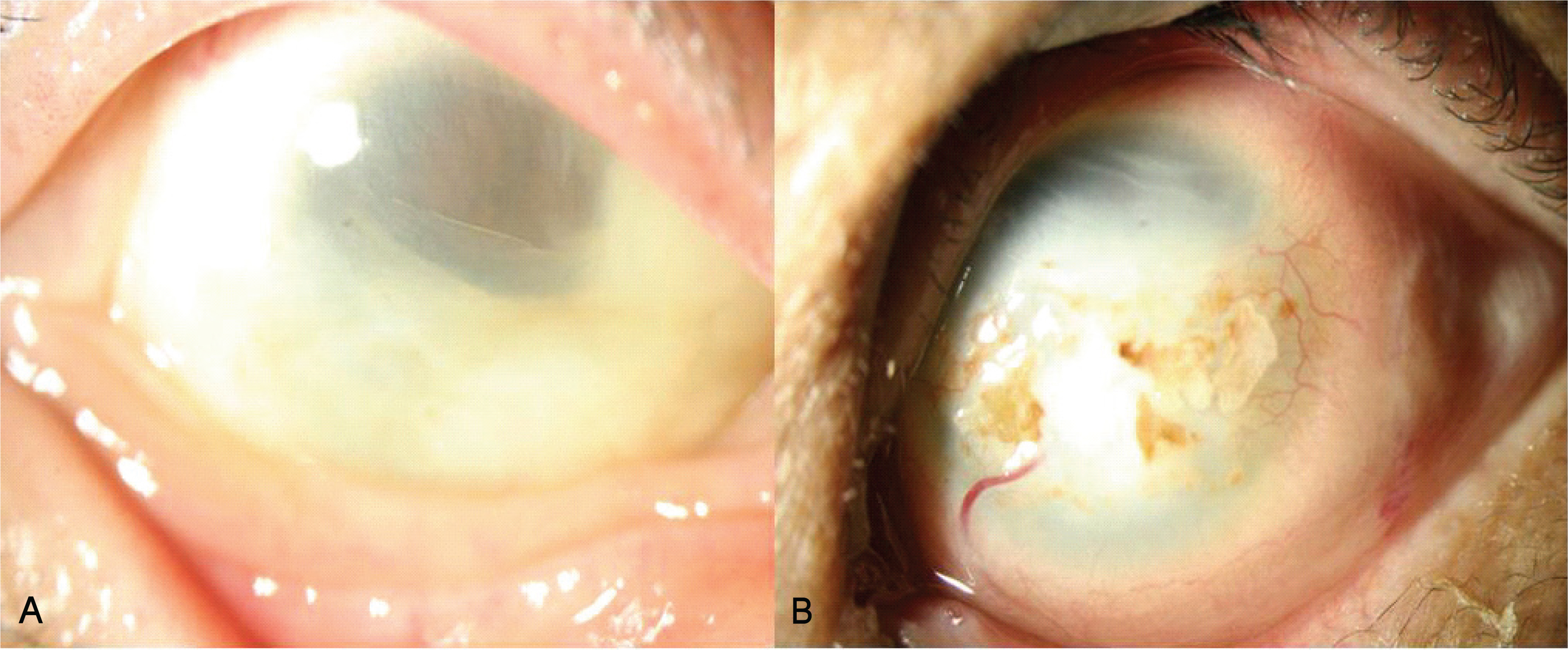J Korean Ophthalmol Soc.
2009 Mar;50(3):477-480. 10.3341/jkos.2009.50.3.477.
Ocular Manifestation of Compound Heterozygotic Mutation in Congenital Erythropoietic Porphyria
- Affiliations
-
- 1The Institute of Vision Research, Department of Ophthalmology, College of Medicine, Yonsei University, Seoul, Korea. shadik@yuhs.ac
- KMID: 2111262
- DOI: http://doi.org/10.3341/jkos.2009.50.3.477
Abstract
-
PURPOSE: Congenital erythropoietic porphyria (CEP) is a rare disorder inherited as an autosomal recessive trait, which is characterized by almost complete reduction of uroporphyrinogen III synthase (UROS) activity. The authors of the present study report a case of congenital erythropoietic porphyria with severe ocular involvement.
CASE SUMMARY
A 27-year-old male patient diagnosed with congenital erythropoietic porphyria was referred to our clinic with a history of ocular pain, and foreign body sensation in both eyes. Visual acuity was light perception in both eyes. Severe scarring of eyelids, corneal leukoma with neovascularization, total limbal deficiency and scleromalacia were observed in both eyes. Identification of the uroporphyrinogen III synthase (UROS) gene mutation revealed the patient had a compound heterozygote mutation at p.Q249X (c.745C>T) and p.L237P (c.710T>C) in exon 10.
CONCLUSIONS
CEP is clinically characterized by severe cutaneous photosensitivity, hemolytic anemia and porphyriuria. In addition to these manifestations, the authors report a severe ocular involvement in a patient with CEP who had a compound heterozygote mutation at p.Q249X (c.745C>T) and p.L237P (c.710T>C) in exon 10.
MeSH Terms
Figure
Reference
-
References
1. Sassa S, Kappas A. Molecular aspects of the inherited porphyrias. J Intern Med. 2000; 247:169–78.
Article2. Shigeru S. Modern diagnosis and management of the porphyrias. Br J Ophthalmol. 2006; 135:281–92.3. Douglas WH. Congenital phophyria: general and ocular manifestations. Trans Ophthalmol Soc U K. 1972; 92:541–53.4. Han HJ, Lee SK. Ophthalmic manifestations in congenital erythropoietic porphyria. J Korean Ophthalmol Soc. 1982; 23:271–4.5. Kang TW, Oh SW, Kim MR, et al. Compound heterozygosity for a premature termination codon and missense mutation in the exon 10 of the uroporphyrinogen III cosynthase gene causes a severe phenotype of congenital erythropoietic porphyria. J Eur Acad Dermatol Venereol 2008 Jul 28 [Epub ahead of print].6. Xu W, Astrin KH, Desnick RJ. Molecular basis of congenital erythropoietic porphyria: mutations in the human uroporphyrinogen III synthase gene. Hum Mutat. 1996; 7:187–92.
Article7. Wiederholt T, Poblete-Gutierrez P, Gardlo K, et al. Identification of mutations in the uroporphyrinogen III cosynthase gene in German patients with congenital erythropoietic porphyria. Physiol Res. 2006; 55:S85–92.8. Ueda S, Rao GN, LoCascio JA, et al. Corneal and conjunctival changes in congenital erythropoietic porphyria. Cornea. 1989; 8:286–94.
Article9. Kurihara K, Takamura N, Imaizumi S, et al. Ocular involvement caused by the accumulation of porphyrins in a patient with congenital erythropoietic porphyria. Br J Ophthalmol. 2001; 85:1265–6.
Article10. Piomelli S, Poh-Fitzpatrick M, Seaman C, et al. Complete suppression of the symptoms of congenital erythropoietic porphyria by long-term treatment with high-level transfusions. N Eng J Med. 1986; 314:1029–31.
Article11. Tezcan I, Xu W, Gurgey A, et al. Congenital erythropoietic porphyria successfully treated by allogeneic bone marrow transplantation. Blood. 1998; 92:4053–58.
Article12. Thomas C, Ged C, Nordmann Y, et al. Correction of congenital erythropoietic porphyria by bone marrow transplantation. J Pediatrics. 1996; 129:453–6.
Article13. Harada FA, Shwayder TA, Desnick RJ, Lim HW. Treatment of severe congenital erythropoietic porphyria by bone marrow transplantation. J Am Acad Dermatol. 2001; 45:279–82.
Article
- Full Text Links
- Actions
-
Cited
- CITED
-
- Close
- Share
- Similar articles
-
- A Case of Congenital Erythropoietic Porphyria
- Parkin Gene Mutation in Korean Patients with Young Age Onset Sporadic Parkinson's Disease
- Acute Intermittent Porphyria Presenting with Periodic Leg Pain
- Persistent goiter with congenital hypothyroidism due to mutation in DUOXA2 gene
- A Case of Acute Intermittent Porphyria in Pregnancy


